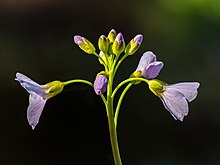| Cardamine pratensis | |
|---|---|

| |
| Scientific classification | |
| Kingdom: | Plantae |
| Clade: | Tracheophytes |
| Clade: | Angiosperms |
| Clade: | Eudicots |
| Clade: | Rosids |
| Order: | Brassicales |
| Family: | Brassicaceae |
| Genus: | Cardamine |
| Species: | C. pratensis |
| Binomial name | |
| Cardamine pratensis L. | |
| Synonyms | |
| |
Cardamine pratensis, the cuckoo flower, lady's smock, mayflower, or milkmaids, is a flowering plant in the family Brassicaceae. It is a perennial herb native to Eurasia.
Description
Cardamine pratensis is a herbaceous, hairless, perennial plant growing to 60 centimetres (24 in) tall, with pinnate leaves 5–12 cm (2–4+3⁄4 in) long with 3–15 leaflets, each leaflet about 1 cm long. The flowers are produced on a spike 10–30 cm (4–12 in) long, each flower 1–2 cm in diameter with four very pale violet-pink (rarely white) petals. The fruit is a seed pod up to 5 cm (2 in). It grows best close to water.
Etymology
The specific name pratensis is Latin for "from/of the meadow".
Its common name cuckoo flower derives from the formation of the plant's flowers at around the same time as the arrival each spring of the first cuckoos in the British Isles. An alternative 16th century dated tale refers to 'cuckoo spit', which the plant is sometimes covered in, due to a bug called the froghopper and not the cuckoo.
Distribution
The species is widespread in Europe and commonly found throughout the British Isles.
Recorded in Ireland from all 40 of the "vice-counties" (a system adopted by Robert Lloyd Praeger in 1901).
Cultivation
It is grown as an ornamental plant in gardens, and has become naturalised in North America as a result of cultivation. In some European countries, including parts of Germany, the plant is now under threat.
It is a food plant for Anthocharis cardamines (the orange-tip butterfly).
Uses
The plant is edible with a peppery taste similar to watercress.
In culture
In folklore it was said to be sacred to the fairies, and so was unlucky if brought indoors. It was not included in May Day garlands for the same reason.
It is the county flower of the English county of Cheshire.
Gallery
-
 Cardamine pratensis in Bavaria, Germany
Cardamine pratensis in Bavaria, Germany
-
Cardamine pratensis growing in Wiltshire, UK
-
 Details of flowers
Details of flowers
-
Buds of a Cardamine pratensis
-
 Botanical illustration from Otto Wilhelm Thomé Flora von Deutschland, Österreich und der Schweiz 1885, Gera, Germany
Botanical illustration from Otto Wilhelm Thomé Flora von Deutschland, Österreich und der Schweiz 1885, Gera, Germany
-
 Flowers
Flowers
-
 Plants
Plants
-
 Flowers, pinker variety
Flowers, pinker variety
-
Seedling
References
- ^ Webb, D.A., Parnell, J. and Doogue, D. An Irish Flora 1996. Dundalgan Press, Dundalk. ISBN 0-85221-131-7
- ^ Francis-Baker, Tiffany (2021). Concise Foraging Guide. The Wildlife Trusts. London: Bloomsbury. p. 64. ISBN 978-1-4729-8474-6.
- "Lady's Smock | Wildflowers | Wildlife". www.wildlifetrusts.org. Retrieved 2016-10-10.
- Reader's Digest Field Guide to the Wild Flowers of Britain. Reader's Digest. 1981. p. 57. ISBN 978-0-276-00217-5.
- Clapham, A.R., Tutin, T.G. and Warburg, E.F. 1968. Excursion Flora of the British Isles. Cambridge University Press. ISBN 0-521-04656-4
- Scannell, M.J.P and Synnott, D.M. 1972. Census Catalogue of the Flora of Ireland. Dublin
- Howard, Michael. Traditional Folk Remedies, (Century, 1987); p
- "Cuckooflower | Plant & fungi species | Wild plants". www.plantlife.org.uk. Archived from the original on 2017-01-03. Retrieved 2016-10-10.
External links
- Blanchan, Neltje (2002). Wild Flowers: An Aid to Knowledge of our Wild Flowers and their Insect Visitors. Project Gutenberg Literary Archive Foundation.
| Taxon identifiers | |
|---|---|
| Cardamine pratensis |
|
- Cardamine
- Flora of France
- Flora of Western Asia
- Flora of Portugal
- Flora of China
- Flora of Japan
- Flora of Korea
- Flora of Denmark
- Flora of Ireland
- Flora of Norway
- Flora of the United Kingdom
- Flora of the Czech Republic
- Flora of Lithuania
- Flora of Greece
- Flora of Italy
- Flora of Latvia
- Flora of Spain
- Flora of Greenland
- Flora of Connecticut
- Plants described in 1753
- Taxa named by Carl Linnaeus